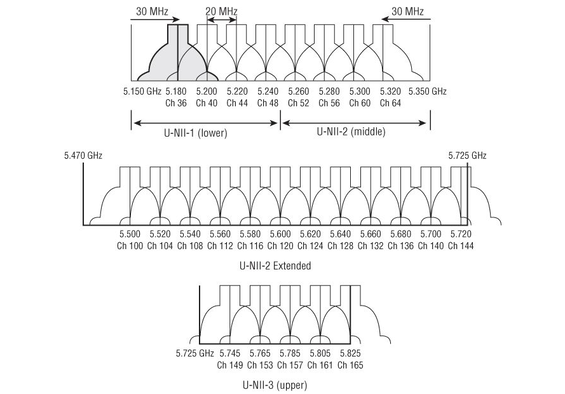OFDM
. . . .
OFDM
- Orthogonal Frequency Division Multiplexing (OFDM) is one of the most popular communications technologies, used in both wired and wireless communications.
- The 802.11-2012 standard specifies the use of OFDM at 5 GHz and also specifies the use of ERP-OFDM at 2.4 GHz.
- OFDM and ERP-OFDM are the same technology. OFDM is not a spread spectrum technology, even though it has similar properties to spread spectrum, such as low transmit power and using more bandwidth than is required to transmit data.
- OFDM 802.11a radios can transmit at 6, 9, 12, 18, 24, 36, 48, or 54 Mbps
- OFDM actually transmits across 52 separate, closely and precisely spaced frequencies, often referred to as subcarriers, as illustrated in Figure 6.7.
- The frequency width of each subcarrier is 312.5 KHz. The subcarriers are also transmitted at lower data rates, but because there are so many subcarriers, overall data rates are higher.
- The 52 subcarriers are numbered from –26 to + 26.
- Because of the lower subcarrier data rates, delay spread is a smaller percentage of the symbol period, which means that ISI is less likely to occur.
- OFDM technology is more resistant to the negative effects of multipath than DSSS and FHSS spread spectrum technologies.
Forty-eight of the subcarriers are used to transmit data. The other four, numbers –21, –7, + 7, and + 21, are known as pilot carriers. These four are used as references for phase and amplitude by the demodulator, allowing the receiver to synchronize itself as it demodulates the data in the other subcarriers.
Convultional coding
- To make OFDM more resistant to narrowband interference, a form of error correction known as convolutional coding is performed.
- The 802.11-2012 standard defines the use of convolutional coding as the error-correction method to be used with OFDM technology. It is a forward error correction (FEC) that allows the receiving system to detect and repair corrupted bits.
- There are many levels of convolutional coding. Convolutional coding uses a ratio between the bits transmitted vs. the bits encoded to provide these different levels.
- The lower the ratio, the less resistant the signal is to interference and the greater the data rate will be.
- Table 6.4 displays a comparison between the technologies used to create the different data rates of both 802.11a and 802.11g.
- Notice that the data rates are grouped by pairs based on modulation technique and that the difference between the two speeds is caused by the different levels of convolutional coding.
Modulation
- OFDM uses binary phase shift keying (BPSK) and quadrature phase shift keying (QPSK) phase modulation for the lower ODFM data rates.
- The higher OFDM data rates use 16-QAM and 64-QAM modulation.
- Quadrature amplitude modulation (QAM) is a hybrid of phase and amplitude modulation.
- A constellation diagram, also known as a constellation map, is a two-dimensional diagram often used to represent QAM modulation.
- A constellation diagram is divided into four quadrants, and different locations in each quadrant can be used to represent data bits.
- Areas on the quadrant relative to the horizontal axis can be used to represent various phase shifts.
- Areas relative to the vertical axis are used to represent amplitude shifts.
- A 16-QAM constellation diagram uses sixteen different combinations of phase and amplitude shifts, as shown in Figure 6.9. Each of the sixteen different points within the four quadrants can be used to represent four data bits.
- With the introduction of OFDM in 802.11a, along with its expanded use in 802.11g, 802.11n, and 802.11ac, the frequency width used by an OFDM channel is approximately 20 MHz
- As seen in Figure 6.19 of the OFDM spectrum mask, the sideband carrier frequencies do not drop off very quickly, and therefore the sideband frequencies of two adjacent valid channels overlap and are more likely to cause interference.
- The 802.11a amendment, which originally defined the use of OFDM, required only 20 MHz of separation between the center frequencies for channels to be considered nonoverlapping.
- All 20 MHz channels in the 5 GHz U-NII bands use OFDM and have 20 MHz of separation between the center frequencies. Therefore, all 5 GHz OFDM channels are considered nonoverlapping by the IEEE.
- In reality, some sideband carrier frequency overlap exists between any two adjacent 5 GHz channels.
- Luckily, due to the number of channels and the channel spacing, it is easy to separate adjacent channels and prevent interference with a proper channel reuse plan.
Reference:
Coleman, David D.,Westcott, David A. CWNA: Certified Wireless Network Administrator Official Study Guide: Exam CWNA-106 Wiley.
Coleman, David D.,Westcott, David A. CWNA: Certified Wireless Network Administrator Official Study Guide: Exam CWNA-106 Wiley.
|
|






